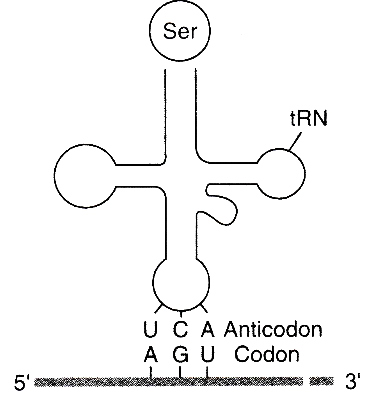(a) Structure of tRNA :
tRNA (Transfer RNA), also called as soluble RNA (sRNA) is a small RNA containg about 80 nucleotides folded over itself in such a way that about 60% of it becomes a double stranded structure while the rest remains single stranded. This folding of tRNA gives it a clover leaf like structure (R Holley 1966), but it looks like an L-shaped structure, (Kim 1971). tRNA has two recognition sites : the anticodon site (Complementary to the codon of mRNA) and the amino acid binding site-CCA-OH at 3' end. Besides this has two lateral arms, the Ribosomal binding arm and the DHU arm. The former helps in ribosomal binding and the latter is related with formation of polypeptide bonds between amino acids. In between anticodon loop and ribosomal binding arm there is present a small lump or mini loop.
Initiator t-RNA recognises start codon (AUG)/ t-RNA act as the adapter molecule that reads the genetic code. Two such charged t-RNA are brought close enough to favour peptide bond formation.

t-RNA has an anticodon loop that has bases complementary to the code, and it has also an amino acid accepter end to which it binds to amino acid.
Amino acid are activated in the presence of ATP, and linked to their cognate t-RNA, called as charging/amino-acylation of t-RNA.
(b) Role of tRNA in translation :
The tRNA is meant for transferring amino acid to ribosomes for the synthesis of polypeptide chain. The tRNA pick up the specific amino acids at their CCA or 3' end & the charged tRNA take the same to mRNA over particular codon corresponding to their anticodons. The tRNA hold the peptidal chain over rnRNA.